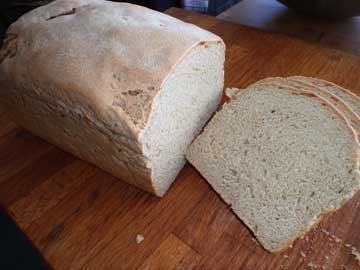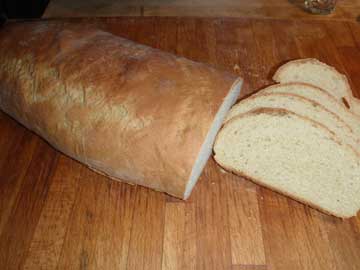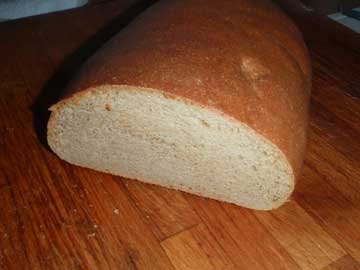Kamut Bread (including sourdough version)
(Kamut is good for people with wheat allergies, though, because it contains gluten, is not for celiacs. It is an ancient grain, a predecessor of the hard wheat used in pasta. I use kamut to make pasta and pizza dough. All kamut is grown organic and in non-GMO form. More on kamut at http://www.kamut.com/)



Ingredients:
5 cups of kamut flour
2 cups of luke-warm water
1 Tbsp dry yeast
1 tsp sugar
1 Tbsp salt
6 Tbsp cup virgin olive oil
butter to grease pan
(You may replace 1 cup water and 1 cup flour by 2 cups sourdough made from a starter. The third bread down is made from sourdough only and no yeast and sugar--it took a long time to rise, 6+4 hours for first and second rise. But the bread rises faster if you use the yeast.)
Preparation:
Combine kamut flour and salt. Dissolve yeast and sugar in water and leave until foamy. Add oil then mix with flour and knead about 12-15 minutes by hand or 8-10 minutes using mixer and dough hook. (This is necessary because the gluten has to be worked harder than that of regular wheat to form the gluten strings and sheets that will trap the gases from the yeast that make the bread rise.) Cover with wet dish towel and let rise for 1 hour. Punch down, knead for 1 minute adjusting consistency with flour or water--you do not want it to be too soft. Put in 9'' x 3 1/2'' loaf pan. Let rise for 45 minutes. Then heat oven to 450 F and let bread rise another 15 minutes. Put the bread in the oven and immediately decrease temperature to 400 F. (This is like baking in a traditional bread oven where the temperature always fell during the baking process.) Bake for 35 minutes. Test with wooden skewer (has to come out dry) or tap the bottom (sounds hollow) for readiness.
Alternative:
As you can see to the left, you can also bake the bread in load form. Just make sure that the consistency is firm enough so that the dough does not run sideward. You can check the consistency after the first rise. If it doesn't form a good dome in the bowl that you use, then knead more flour into the dough until it is firmer.
Taste notes:
This one is nice, chewey, a fine texture. The bread has a nice yellow color from the kamut flour. You will see, it tastes for MORE, and it is more delicious than delissio. The sourdough version (3rd image) is even more chewey, slightly sour and slightly moist. It is fantastic.